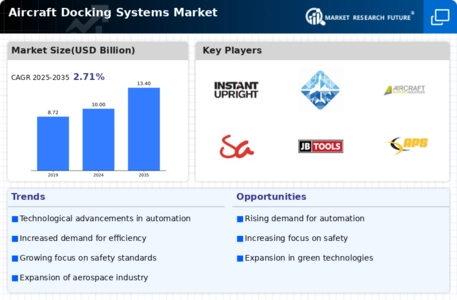Market Analysis
In-depth Analysis of Aircraft Docking Systems Market Industry Landscape
The Aircraft Docking Systems market is witnessing notable trends that are reshaping its landscape and influencing its growth trajectory. One significant trend is the increasing emphasis on efficiency and safety in aircraft maintenance operations, driven by the growing complexity of modern aircraft and the need to minimize downtime. Aircraft docking systems play a crucial role in providing safe and stable platforms for technicians to access various areas of an aircraft during maintenance, repair, and overhaul (MRO) activities. As airlines and MRO facilities strive to optimize their operations and reduce turnaround times, there is a growing demand for advanced docking systems that offer enhanced functionality, flexibility, and ease of use. Manufacturers are responding to this trend by developing innovative docking solutions equipped with features such as adjustable platforms, telescopic gangways, integrated lighting, and automated positioning systems, enabling more efficient and streamlined maintenance operations.
Moreover, technological advancements are driving innovation and shaping market trends in the Aircraft Docking Systems segment. Manufacturers are leveraging advancements in materials science, engineering, and digital technology to develop next-generation docking systems that offer improved performance, durability, and reliability. For example, the integration of digital technologies such as augmented reality (AR) and virtual reality (VR) into docking systems provides technicians with enhanced visualization tools and training capabilities, enabling them to perform tasks more accurately and efficiently. Additionally, the use of advanced sensors and automation technologies enables docking systems to adjust to the specific dimensions and configurations of different aircraft models, enhancing versatility and usability. These technological advancements are driving market adoption and expanding the scope of applications for aircraft docking systems across various segments of the aviation industry.
Furthermore, market trends such as the increasing focus on sustainability and environmental responsibility are shaping the Aircraft Docking Systems segment. Airlines and MRO facilities are increasingly adopting sustainable practices and seeking environmentally friendly solutions to reduce their carbon footprint and comply with regulatory requirements. Manufacturers are responding to this trend by developing docking systems that are designed for energy efficiency, durability, and recyclability. For example, the use of lightweight materials and energy-efficient lighting systems in docking systems helps reduce energy consumption and operational costs while minimizing environmental impact. Additionally, the integration of renewable energy sources such as solar panels into docking systems enables them to operate off-grid and reduce reliance on fossil fuels. These sustainability initiatives are driving market differentiation and influencing purchasing decisions in the Aircraft Docking Systems segment.
Moreover, market trends such as the emergence of new aircraft programs and the expansion of global aviation fleets are driving market growth and innovation in the Aircraft Docking Systems segment. With airlines and military organizations worldwide investing in new aircraft acquisitions and fleet expansions, there is a corresponding need for advanced infrastructure and equipment to support maintenance operations. Manufacturers are capitalizing on this trend by developing customized docking solutions tailored to the specific requirements of modern aircraft models. Additionally, the integration of digital connectivity and data analytics capabilities into docking systems enables real-time monitoring, predictive maintenance, and performance optimization, further enhancing their value proposition for customers. As the aviation industry continues to evolve and expand, the demand for innovative and efficient aircraft docking systems is expected to remain strong, driving market growth and investment in this segment.
Furthermore, market competitiveness and industry consolidation are shaping market dynamics in the Aircraft Docking Systems segment. With several established players and emerging manufacturers competing for market share, competition intensifies, leading to innovation, product differentiation, and pricing strategies. Market leaders invest in research and development to stay ahead of the competition, introduce new technologies, and expand their product portfolios. Additionally, mergers, acquisitions, and strategic partnerships enable companies to strengthen their market position, enhance their capabilities, and access new markets, driving market consolidation and shaping industry dynamics. Overall, the Aircraft Docking Systems market is experiencing significant trends driven by factors such as the demand for efficiency and safety in aircraft maintenance operations, technological advancements, sustainability initiatives, new aircraft programs, and industry competitiveness. By understanding and adapting to these trends, manufacturers, suppliers, and stakeholders can capitalize on emerging opportunities and drive sustainable growth in the Aircraft Docking Systems segment.










Leave a Comment